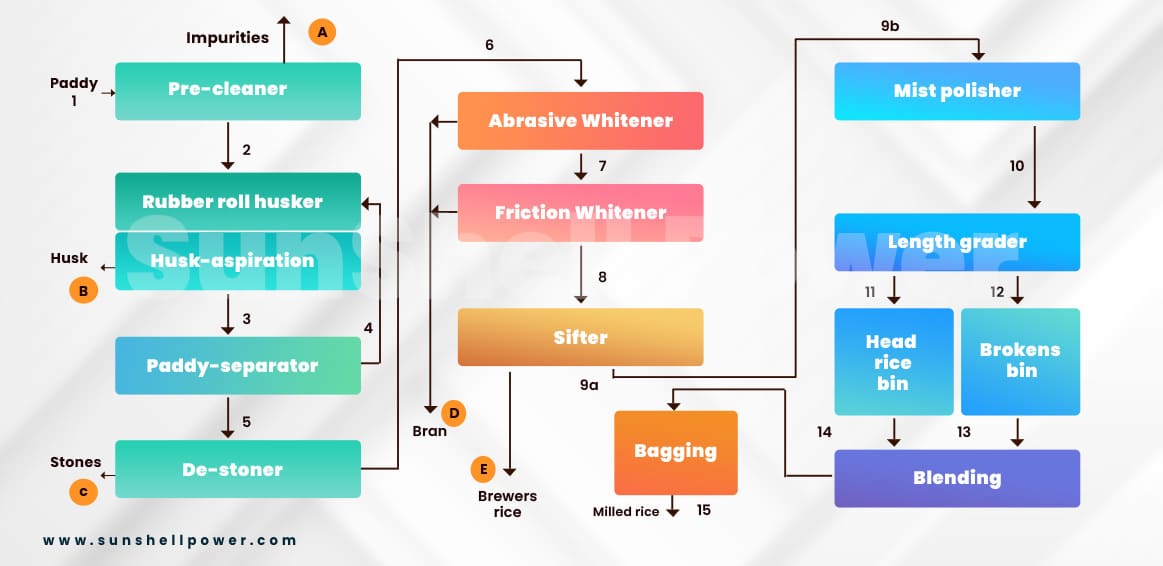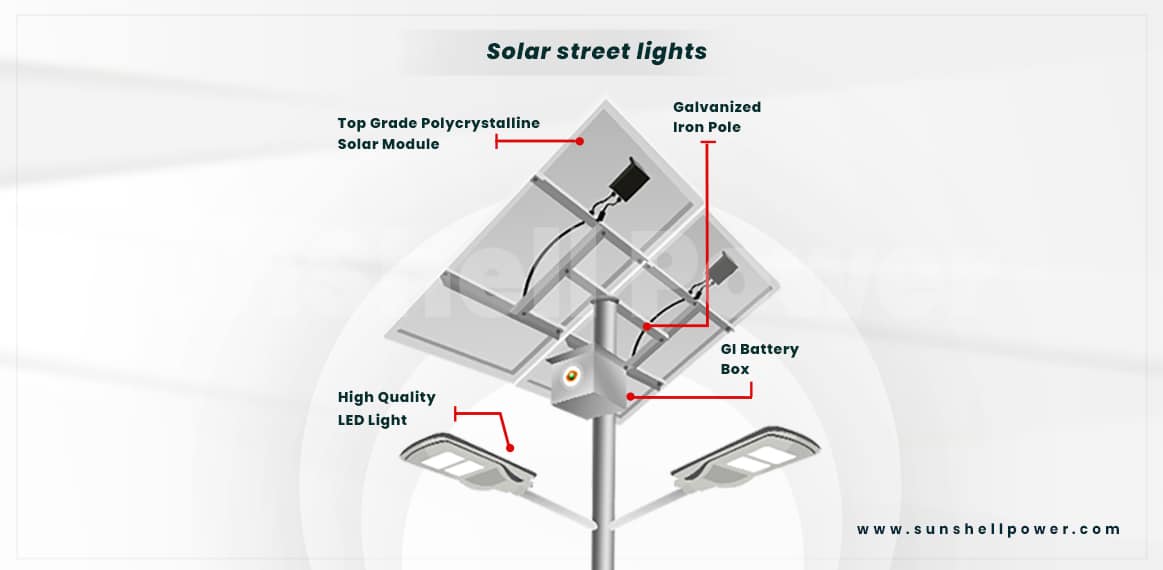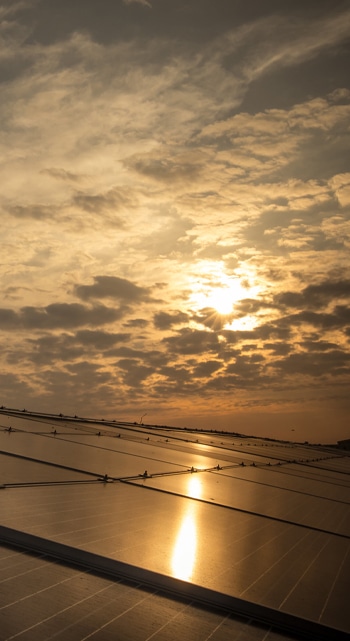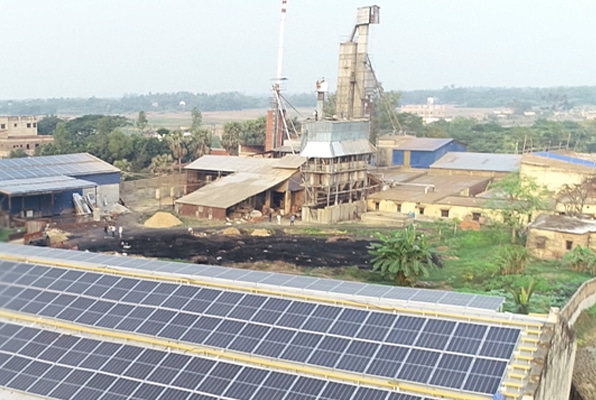India is an agricultural country, producing the largest amount of rice in the world. There are approximately 43.86 million hectares during the year 2020, the country has about 4,000 varieties of rice. But not only rice production, the country consumes around 20% of the global production. Over 50% of India’s 1.4 billion people depend on rice for sustenance.
A rural Indian consumes 6 kg of rice each month on average whereas an urban Indian’s consumption is around 4.5 kg per month.
Indian Govt. has a mandatory policy to reserve 11.5 million tonnes of rice as an operating stock and 2 million tonnes as a strategic reserve of rice as rice demand is much higher in the country compared to others. So, rice processing is as important as the production process.
A rice mill is a food processing facility that converts paddy into rice for market sale. In India, there are approximately 1,30,000 rice milling units.
If categorized based on production size , in India there are mainly two types of mills, Village Rice Mills and Commercial Mills.
In commercial rice mills, based on the production process and machineries used there are three types of mills,
- Automatic Rice Mills,
- Semi-automatic Rice Mills,
- Manual Rice Mills.
As technology progresses, the rest of the world is adopting automatic rice mills more and more . But for the case of India majority of them are semi-automatic but 86,000 of them are using outdated equipment.
To maintain the working process of these rice mills, the main component is reliable power as the entire process of milling rice is not just to convert paddy into rice , but also to ensure the durability of the seed by polishing ,drying etc. These machineries need a reliable source of power as if the power cut happens the surge wattage and material loss in these machineries is a lot.
To deeply dive into the problems and industrial scenarios of these mills ,at first we need to know how rice mills work and about various machinery used there. In India the majority of the rice mills are semi-automatic, so here we will know about the working process of a semi-automatic rice mill.
Components & Working Process of Rice Mills
The semi-automatic rice mills of India have various sections:
- Parboiling Section: This section is responsible for the conditioning of rice crops by partially cooking and drying beforehand. This process can be practiced a number of times before processing further. Single-stage, dual-stage, and even triple-stage systems are available here.
- Drying Section: The moisture level of the crop is reduced at this stage, and the seeds are dried to ensure the crop’s long-term viability. The seed life is doubled if the moisture level of the seed is less than 14%.
- Milling Section: The basic objective of this process is to remove the unwanted parts, non-edible parts of the rice. The rubber roll huskers remove any undesirable components. A normal rice crop has a 20 percent hull or husk, 11 % bran layers, and 69%starchy endosperm composition when harvested.
- Bagging Section: The processed rice is bagged and packaged in this part in a sanitary manner to protect it from external elements such as humidity, pressure, and temperature.

Electrical Load & Consumption
The electrical consumption of a rice mill depends on various factors
- Account of Machinery( Load & Standby)
- Electricity Usage :
- Room Lighting
- Security system including CCTV
- Compound Lighting
- Submersible pumps etc.
Normally a medium size rice mill has motors ranging from 25 HP to 60 HP with various boiling and pumping stations. The average electrical consumption of a rice mill is around 1,183,271 kWh/ year . Specifically, the energy consumption of a rice mill is around 19.50 kWh/ton on a global basis. The daily average active hours of a rice mill is around 12 hours, starting from 6 a.m. to 6 p.m.
So, the electrical demand of a rice mill solely depends on the production capacity of the mill.
Power Backup
Majority of the rice mills use DG motors as their backup power source. The steam powered engines have also been used as a backup for mills. As these mills are usually set up, far from the locality and in rural areas ,surveys have shown that these plants lose grid power about 2-3 hours daily. So, on an average these mills use 400 KVA inductive load for a period of 2.5 hours approximately , consuming 172 liter of diesel everyday , emitting 464.4 kg of CO2 . To recycle this much carbon in a day approximately 7,740 no. of trees are required.
Carbon Emission
An average rice mill in India, emits around 95kg of carbon per hour,which requires 20 trees to be recycled in a year.
Problems faced by Rice Mills
Even though the industry seems to have a profitable and ever-growing market with an efficient manufacturing process ,it is always not the case:
- Diesel motors require a higher operational cost,
- As tariff charges goes higher and higher, the electricity cost of various rice mills goes up exponentially,
- Huge carbon emission, harmful for the environment,
- Grid energy is unreliable as frequent power cuts are a common thing.
So, What’s The Way Out? Solar Solutions for Rice Mills!!!
As technology evolves, human civilization moves towards renewable power more and more. Moreover, solar plants are the most reliable source of renewable power. We at SunShell Power, offer solar rooftop solutions for every problem in the rice mills. Solar modules have a lifespan of 25 years with minimal maintenance , which makes them super reliable and efficient.
For the rice mills, we offer five types of rooftop solutions:
- Grid-connected Solar Rooftop Plant,
- Solar Submersible Pump,
- Solar Street Light,
- Usage of VFD in motors,
- Energy Auditing
Grid-connected Solar Rooftop Plant
Reliable and efficient grid-connected solar rooftop power plants with minimalistic maintenance and available net-metering facility, a credit system through banking of power. This is an appropriate power plant if power outages are rare and facilities have a high electrical load.

Why On-Grid ?
Even if every solar plant is important to SunShell Power, for rice mills we highly suggest the authorities install on-grid solar power plants. From our previous experiences, we have pointed out several points, which clearly makes Grid-connected plant an ideal choice:
- These systems are best suitable when power consumption is high and for cost reduction of electricity bills,
- On-grid systems can be installed with or without net-metering,
- On-grid solar systems are very cost -effective and easy to install,
- As there is no battery backup ,maintenance is minimal ,which can be helpful in the busy environment of the rice mills.
Benefits of Solar Solutions for Rice Mills
Now, the question may arise to your mind-why should I invest in solar ?
- Solar power plants are a terrific financial and economical investment that is unquestionably a reliable source of power, in addition to being environmentally beneficial and creating green energy. We’ve compiled a list of six overall solar benefits based on feedback from prior customers.
- Reduced electricity bills as dependency on conventional electricity and DG is reduced,
- Government gives subsidy for solar panel installations,
- Tax benefits by going for accelerated depreciation,
- Low maintenance and long lifespan,
- Environment-friendly solar power is the best way to preserve our planet,
- Proper utilization of the unused space on roof shades

Average ROI
The average payback of a grid-connected solar power plant in a rice mill is around 3.5-4.5 years, although it can change based on the electrical load of the rice mill.

Alternate Solutions
- Hybrid Solar Plant: As majority of the Indian rice mills suffer from frequent power cuts, as the grid connected power supply is unreliable due to load fluctuations caused by the variable demand of the steel factory machineries , hybrid power plants are also preferable ,as the backup battery reduces the facilities dependence on DG backup motors, reducing much carbon emission in the environment. But , as the required load in the rice mills is much higher , batteries with much higher quality and larger storage capacity are recommended.
- Off-grid Plants : As hybrid plants are costly and may exceed some initial investment budget of many facilities to install a solar plant with backup , the next best option is off-grid plants. In case of frequent power cuts and outages , application of such would keep the steel factory active for a few more hours.
Overall Benefits of Solarized Rice Mills:
- Hedge against rising energy costs ,
- Scalable design for easy upgradation and according as the need ,
- RPO Compliance,
- Proper utilization of roof space ,
- Self-reliance ,
- Green Commitment ,
- Government gives subsidies for solar panels installations.
- Become a part of the go green mission.
- Solar Submersible Pump: As massive boiling stations and heat generating machineries are key-components of a rice mill, constant supply of water is essential. Solar submersible pumps are ideal for pumping water from underground for both toilet and cooling purposes.
- Solar Street Lights: As the compound area of a rice mill is huge and regular operations of transport vehicles are a common scenario here ,proper illumination is an important subject. Majority of the rice mills have storage facilities where costly rice grains are supposed to be stored, where these solar lights can be used as a safety equipment during the night time.

- Two in One( Semi-integrated) : Used for a variety of purposes, these are easy to install and are low-maintenance.
- Solar Mini Mast: Best for places with unstable power sources, uses green energy and needs almost zero maintenance.
Variable Frequency Drive
A Variable Frequency Drive (VFD) is a type of motor controller that drives an electric motor by varying the frequency and voltage of its power supply system. The VFD may also control the motor’s ramp-up and ramp-down during start and stop, respectively.Despite the fact that the drive regulates the frequency and voltage of the power supplied to the motor, we commonly refer to it as speed control since the outcome is a change in motor speed.
So, for energy savings, intelligent motor control and reduction of surge voltage during the start, pause and shut down time.
If a 15 HP motor is used with VFD at the base speed of the motor is 1000rpm at 500rpm , it will fall to 7.5 HP in all conditions ,if the motor load is a variable type of load it will by a cubic ratio.
Thus allowing a VFD to reduce motor speed can reduce motor energy consumption upto 90% and VFD may save as high as 30% electricity cost bills.
Benefits
Benefits of using VFD or AC motor speed control are as follows:
- A variable frequency drive can vary the power supplied to match the energy requirement of the driven requirement and this is how it conserves energy or optimizes the usage.
- Energy consumption is drastically reduced compared to the DOL(Direct-on-line)operation of the motor.
- On AC variable frequency drives (VFDs), dynamic braking resistors are utilized to waste energy created in the motor as the drive applies braking torque to stop the motor.
Energy Auditing
Energy auditing is an energy assessment. This assessment looks at how energy flows through a structure, process, or system in order to minimize energy input while preserving or increasing human comfort, health, and safety. According to the definition of ISO 50002 standard, an energy audit is a systematic analysis of energy use and energy consumption within a defined energy audit scope, in order to identify, quantify and report on the opportunities for improved energy performance.
There are three types of energy audits:
- Walk-Through Audit,
- Energy Diagnosis,
- Investment Grade Audit
Depending on the purpose and potential savings the type of energy audit is chosen.
If the priority is to identify potential savings and further studies a walk-through audit is recommended whereas if the intention is to invest a large amount of money in energy efficiency measurement an Investment Grade Audit is done.
Benefits of Solar Solutions for Rice Mills
- Energy auditing helps reduce costs in the facility,
- It helps reduce environmental damage and pollution,
- If any energy is active then it can be detected.
Become A Part of The Green Future
As the world has determined to go carbon neutral ,India has also set a target of net-zero emission by the year 2070. Govt. are offering various schemes and policies for solar installations, it is our duty to play our part to make this green mission a success.
Various rice mills in India have adopted solar plants to produce their own green energy and also get credit from the net-metering facility. Krishna RIce Mill in Kapurthala, Punjab,M/S Devendra Rice Mill in Gondia has adopted solar energy.
In the year 2020, Shab Shiv rice mill in Burdwan, West Bengal installed a 200 kWp solar plant where SunShell Power consulted the entire project to check and make sure the quality ,efficiency and productivity of the plant.
Majority of the rice mills have solar plants which partially powers the mills but as the main operation time of rice mills is during the daytime, rice mills can be fully dependent on grid-connected solar rooftop plants which will play a crucial role in reaching our country’s goal.
Enquire Now

